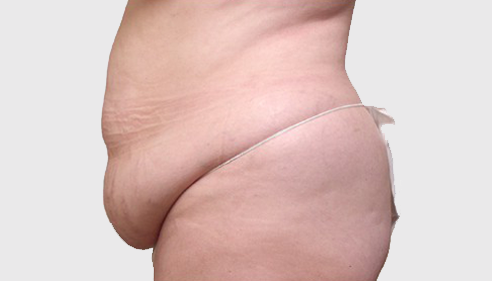Abdominoplasty is a body contouring technique that removes excess skin and fat from the abdomen and may include tightening the abdominal wall. The goal of an abdominoplasty is to improve abdominal contour. For optimal results, it is important to reach your weight loss goals before undergoing this procedure, the extent of which will vary depending on the severity of the problem. The surgical approach will be determined during the initial consultation with your surgeon.
An abdominoplasty removes excess skin and fat and tightens laxity typically seen after child bearing. An incision is generally made in the natural skin crease above the pubic bone and may be designed so that it is hidden by swimwear. A second small incision is cut around the navel. The abdominal flap is elevated, the abdominal wall is tightened by placing sutures that lace up the supporting tissue, and the excess skin and fat are removed. Though the scars are permanent, they usually fade within the first year of surgery.
An abdominoplasty may be extended around the hips to remove what is commonly known as “love handles.” In fact, it can be extended all of the way around the waist. This circumferential abdominoplasty has been referred to as a “belt lift.” The belt lift has the added benefit of a buttock lift, which may be desirable in massive weight loss patients. This is a longer operation because it involves turning the patient to work on both the front and the back.
The abdominoplasty may be extended vertically up the midline to accomplish a circumferential skin reduction in situations where either a vertical scar is already present or where the aesthetic benefit outweighs the added presence of a vertical scar.
A panniculectomy simply removes skin and fat that folds over. This procedure is designed to relieve symptoms associated with the fat roll, such as rashes under the skin fold or, in severe cases, difficulty walking. Panniculectomy may be covered by your health insurance, especially after excessive weight loss.
Patients who have limited excess skin above the navel are candidates for a mini-abdominoplasty. A low horizontal incision, similar to that used in abdominoplasty, allows for removal of excess skin and fat. If needed, muscle tightening may be performed from the navel to pubic bone.
Endoscopic abdominoplasty, a procedure that tightens the abdominal wall without removing excess skin, is an option for those patients who only have laxity of the abdominal wall. Patients with only excess fat and good skin elasticity may wish to simply consider liposuction.
The Procedure
All abdominal procedures are performed under general anesthesia and take two to five hours depending on the extent of the surgery. A surgical first assist will participate during surgery to minimize the time under anesthesia.
Before & After Gallery
Dr. Askren | Abdominoplasty
Age: 28. Height: 5 ft. 3 in. Weight: 123 lbs. History: 2 C-Sections. Procedure: Abdominoplasty. Post-op photos: 3 months.
Dr. Zuniga | Abdominoplasty
Age: 30. Height: 5ft. 6 in. Weight: 165 lbs. History: 3 children, 1 C-Section. Procedure: Abdominal Panniculectomy with Abdominoplasty and Liposuction of iliacs. Post-op photos: 24 months.
Dr. Askren | Abdominoplasty
Age: 26. Height: 5 ft. 1 in. Weight: 125 lbs. History: 4 children. Procedure: Abdominoplasty. 20 month post-op photos.
Dr. Zuniga | Abdominoplasty
Age: 53. Height: 5 ft. 6 in. Weight: 138 lbs. History: Excess tissue, no children. Procedure: Abdominoplasty with Liposuction of the Flanks.
Dr. Askren | Abdominoplasty
Age: 37. Height: 5 ft. 4 in. Weight: 160 lbs. History: 2 C-Sections. Procedure: Abdominoplasty with Liposuction of the iliac fat pads. Post-op photos: 12 months.
Dr. Zuniga | Abdominoplasty
Age: 37. Height: 5 ft. 4in. Weight: 157 lbs. History: Laparoscopic Roux-en-Y Gastric Bypass. Procedure: Abdominal Panniculectomy with Abdominoplasty.
Dr. Zuniga | Abdominoplasty
Age: 61. Height: 5 ft. 5 in. Weight: 140 lbs. History: Morbid Obesity S/P Gastric Bypass. Procedure: Abdominoplasty. Post-op photos: 18 months.
CareCredit helps with patient financing. Learn more about your financing options now.





























